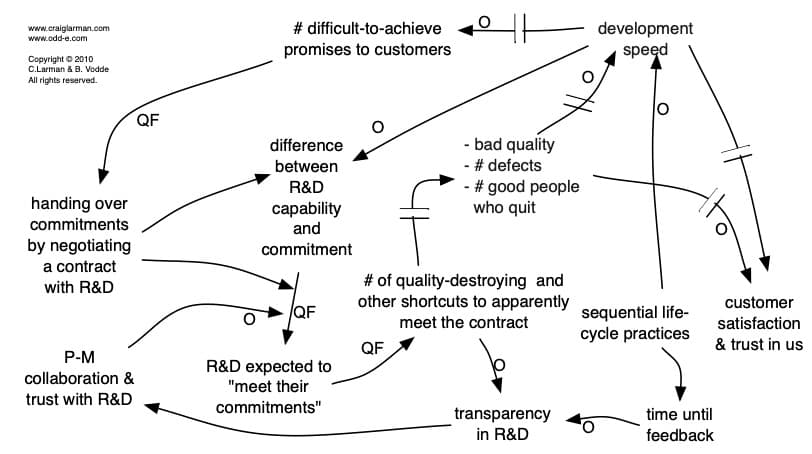Agile Coach – What does it mean?
The term Agile Coach is used differently in different contexts. Here we would like to explain what the term means to us.

An Agile Coach for us is a person who supports organizations to become adaptive and self-learning. The result of an agile coach’s work is, on the one hand, changed processes in an organization, and on the other hand, an organization that changes its processes on its own as needed. In this context, the processes are “only” an externally observable aspect of the change. During the collaboration with an agile coach, the lived values, beliefs, skills and knowledge of the individuals in the whole organization change significantly.
Agile coach vs. management consultant
Agile coaching can be easily distinguished from classic strategic management consulting. A consultant typically solves a complicated problem for his client and hands over a solution and may help with its implementation. A coach supports a client in learning how to solve his problem himself. Both services are valuable in different contexts.
Our context is typically the structure with which work is done in an organization. This includes roles, responsibilities, meetings and intermediate results of individuals and groups. In this context, we believe coaching is the most meaningful and sustainable approach. After all, only the client can take long-term responsibility for his own process.
An outsider does not bear the consequences of his suggestions in the long run and therefore it is not about proposing the “right” solution. Much more important than the “right” solution for one moment is the continuous adaptation of processes to changing needs. In all of the organizations we know, circumstances change significantly on a monthly, weekly, and sometimes daily basis. Therefore, a proposal for processes, even if it is the best solution today, quickly becomes outdated. And so it is most sustainable when an organization learns to ensure that its own process changes serve its own long-term success.
What does the term “Agile” mean?
What is understood under the adjective “Agile” or “agile” in this context? The word agile is used rather rarely outside of our context. Sometimes it’s used for “agile dogs” etc. It helps to look at the history of its origin to better understand what was meant at the time. In 2001 in Snowbird, Utah, where the Agile Manifesto was written and the term “Agile Software Development” was coined, there were several other terms to choose from. Among them were adaptive and flexible.

According to Craig Larman, “adaptive” almost won against the other terms. But one of the participants – Jim Highsmith – had a framework called “Adaptive Software Development” and he had a company called “Adaptive Software Development”. But it was important to find a word that could summarize all the tools and approaches gathered there (Scrum, Extreme Programming, Crystal, Clean Code and others).
So by Agile it is meant that the development work is flexible and adaptive to the changing environment. An Agile coach is someone who supports a company in making the organization more flexible and adaptive.
What do Agile coaches do?
Reflect or mirror
A coach observes and reflects such observations to his client, which can help him become more aware. In the agile context, this skill needs above all practical experience in many different organizations. This helps to know the principles behind agile not only in theory, but also to recognize their (non-)application in reality and to communicate what is observed in an appreciative way. Mirroring or reflection is a continuous part of agile coaching. At the beginning of a collaboration, there is usually an opportunity for an explicit time of observation and reflection. On the one hand, this immediately generates added value, as things often change already during reflection. At the same time, it helps the Agile Coach and the organization get to know each other and define possible next steps. We call this shoulder view (or Agile Assessment).

Training
If it is helpful for the client, an Agile Coach takes the role of the trainer to convey content interactively. Some typical topics of such trainings are Agility, Product Owner, Scrum Master, Communication, Kanban or Scrum in large organizations.
We regularly hold trainings for Scrum Master certification and Product Owner certification, among others. Trainings are a typical part of an agile transition.

Coaching
When an organization takes the first steps toward agility, it usually also means letting go of leaders – less direct instructions, more decision-making space for those being led. This letting go is not passively doing nothing and observing. On the contrary, less direct instruction means the leader starts doing more at a different level. Making clear and shaping more context and framework, encouraging more direct interactions, asking more questions, etc. This is a personal transition process where the support of an experienced coach can be very helpful. If you want to learn how to do this, you are welcome to attend our Certified Agile Leadership Training.
As leadership learns to work “on the system” instead of “in the system,” there are typically new challenges for those being led as well. For them, it’s about taking responsibility for new areas. With new responsibility comes new opportunities to fail. A coach helps in consciously dealing with the fears associated with this, so that in the end, one’s own (learning) successes and the new opportunities to shape things outweigh the fears.

Coaching in organizational design and structure
In large organizations, the factor – organizational structure – determines adaptivity more than any other factor. Organizational structure here means: Hierarchies, role and team definitions and related responsibility structures, salary structures and incentive systems, budget planning processes, etc.
In small organizations, possible dysfunctions that arise due to a structure that has not been thought through can be quickly remedied in personal discussions. After all, most employees still know each other and there is a personal informal connection between different levels of the hierarchy. This changes with the size of the organization.
This is where an Agile Coach helps his client:
- Understand the impact of the current organizational design on the client’s goals and objectives
- Set achievable and helpful goals, that allow for adaptability
- Think through possible changes to the organizational design and design them as experiments
- Execute these experiments and learn from them
In this way, a learning cycle is created at the management level with regard to the changes in the organizational structure and their effects.

Mentoring
Sometimes it is valuable for our clients that we act as a mentor or role model for a limited time. For example, as a role model we moderate a first retrospective to give a new Scrum Master a vivid impression of how to moderate a retrospective. If desired, we also support with suggestions to open up new options for clients. However, the decision to try out an option remains with the client at all times.
We act as mentors, for example, when we observe a person at work and then present and discuss concrete suggestions for improvement with him or her. This role makes sense especially at the beginning of a collaboration and should fade into the background in the course of an agile transition.
Facilitation
Finding solutions, communicating clearly and making shared decisions are often challenges in organizations. This doesn’t get any easier for those who are in the midst of change. We help as experienced facilitators to solve even difficult and complicated problems quickly in groups.
Especially at the beginning of an agile transition, it is not uncommon that the management level wants to make various decisions in workshops to set up the beginning measure.
Agile Coach or Scrum Master?
In Scrum, there is an explicit role for an Agile Coach. This is called Scrum Master in this framework. We have written about the Scrum Master in a very detailed article. There you will find the different characteristics, skills and activities of a Scrum Master described and vividly explained with typical examples from working life. Everything written there also applies to an Agile Coach.
Today we often observe that people who work directly with one or a few development teams are often referred to as Scrum Masters. Agile Coaches are then their more experienced colleagues who work with management, give trainings, etc. Of course, it is understandable that more sensitive tasks are taken on by more experienced colleagues. Basically, working with management is also part of the Scrum Master’s role. And a great Scrum Master understands much more than just Scrum.
Scrum Coach or Agile Coach
For us, the term Scrum Coach therefore means an Agile Coach who specializes in introducing and supporting organizations in Scrum. Just like a good Scrum Master, this person does not limit their knowledge to Scrum only. Typically, a Scrum Coach also advises a company in organizational design, since the introduction of Scrum is also almost always accompanied by a change in organizational structure.
How to become an Agile Coach?
We are not aware of a “standard path” to becoming an agile coach. Many start as developers, some are organizational coaches, and others are managers first. We plan to share something about our own paths to becoming an Agile Coach soon.
A first step is often to formally engage with Agile and Scrum. See our trainings, especially the training for the Scrum Master certification. Here we teach the basic knowledge and fundamentals of many of the skills listed above.